Introduction
The wonderful and characterful hippopotamus (Hippopotamus amphibius) – or hippo for short – with their bulky body on short legs and huge head, is the world’s third largest land mammal, only dwarfed by the elephant, which can also be found in Uganda, and the white rhino. Hippopotamus is Greek for ‘river horse’ and hippos are semi-aquatic, meaning they spend a lot of their time in water, and are often seen basking in most of Uganda’s lakes and rivers.1https://ugandawildlife.org/animals/hippo/
There are 115,000-130,000 hippos left in Africa but their numbers are decreasing at a horrifying rate, making them vulnerable to extinction.2https://www.iucnredlist.org/species/10103/18567364#population In Uganda, they can be found in Murchison Falls, Lake Mburo, and Semiliki National Park, but Queen Elizabeth National Park (QENP) has the most.3https://bwindigorillapark.com/hippos-in-murchison-falls-national-park/ It is estimated that there are around five thousand hippos in QENP.4https://www.queenelizabethparkuganda.com/information/wildlife-in-queen-elizabeth-national-park/ Hippos have a lifespan of 40 years in the wild. Males average 11.5 feet (3.5 metres) long, stand 5 feet tall (1.5 m), and weigh 3.5 tons (3,200 kg), weighing almost one third more than females.
Fascinating facts
Water worshippers
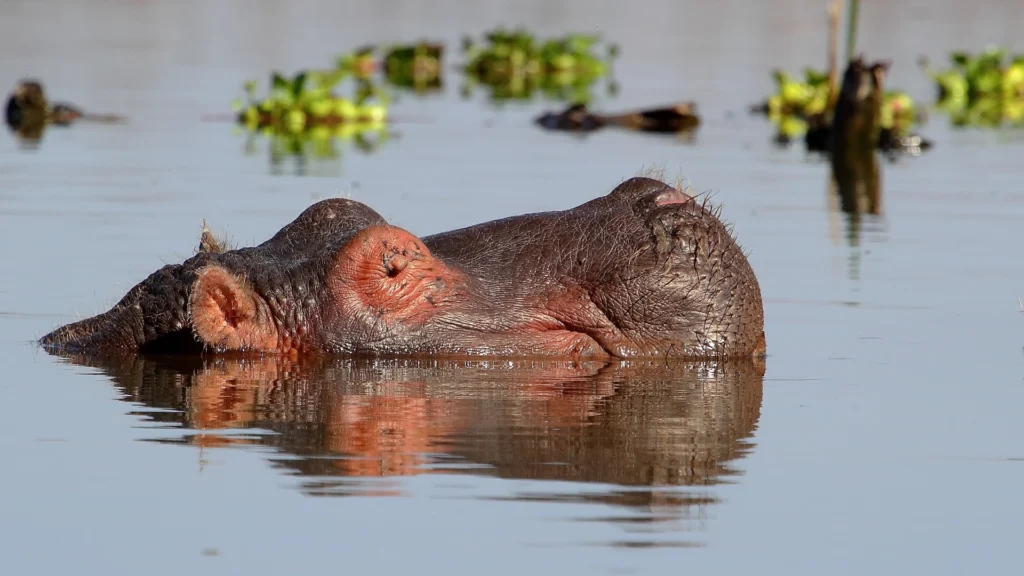
Even though they spend three-quarters of their life in water, hippos can’t swim! In fact, they actually just bounce off the bottom of the river to walk or to surface. They stay in the water to protect their skin from the fierce African sun; to stop dehydration as they quickly lose water through their skin; and to cool off, as they have very few sweat glands. They can hold their breath for five minutes and they even sleep underwater and automatically bob back up to the surface to get air without even waking up.5https://www.nathab.com/blog/africa-story-six-surprising-facts-about-hippos-africa/ Hippos eyes, ears and nostrils are high on their head so that the rest of them can stay submerged. And they can fold shut their ears and nostrils to keep out water.
Walking whales
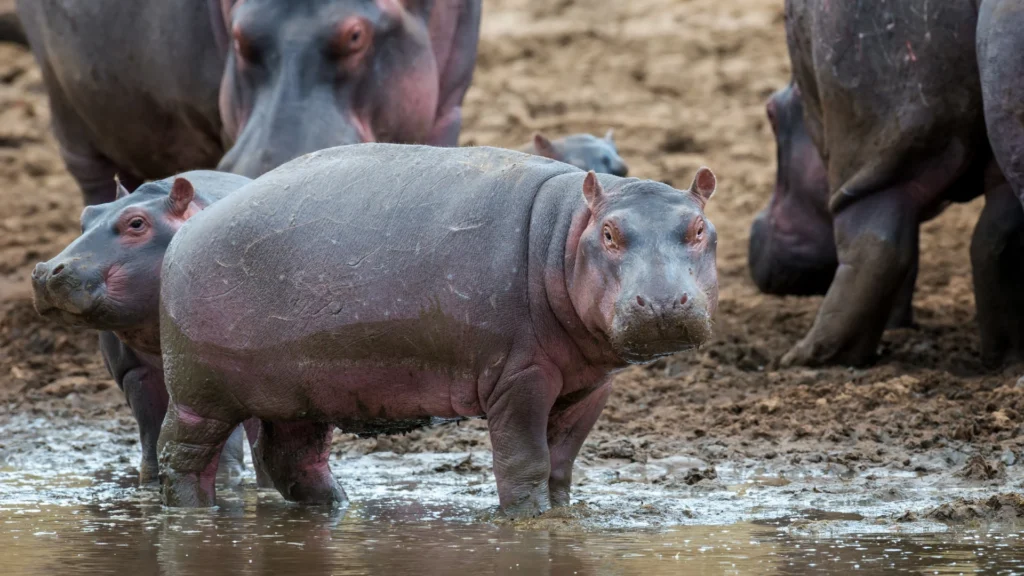
Hippos might look like big pigs – and they are very distantly related – but they’re actually much more closely related to whales and porpoises. This is why a group of hippos is sometimes called a pod or school, like other aquatic mammals.6https://www.nationalgeographic.com/animals/mammals/facts/hippopotamus Some also describe a group of hippos as a “bloat of hippos”7https://www.bbc.com/travel/article/20181108-why-a-group-of-hippos-is-called-a-bloat… but that seems a bit offensive, even if hippos do have thick skin!
Hungry hippos
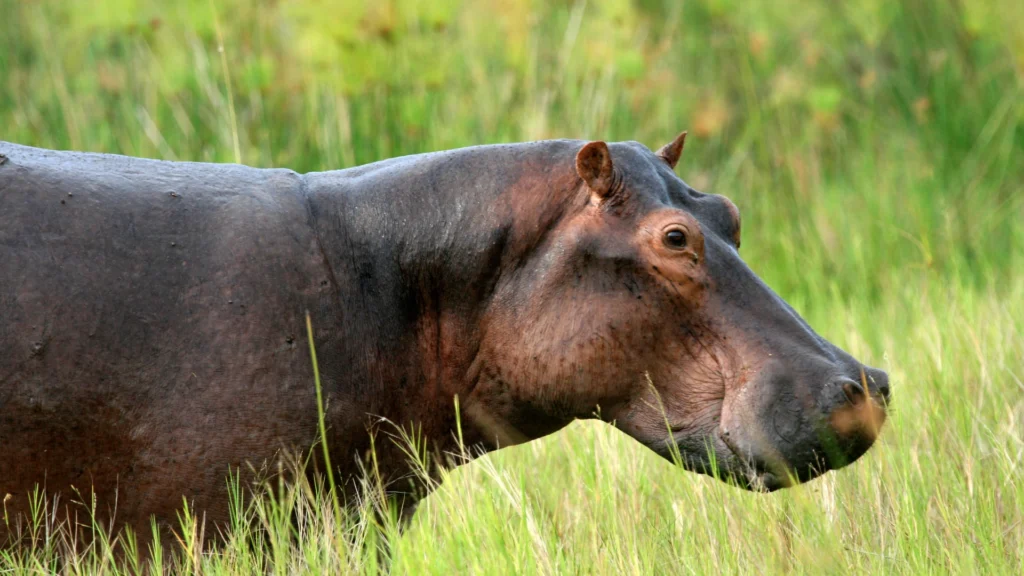
Despite their gaping mouths and terrifying teeth, hippos are herbivores and spend a lot of time eating grass and aquatic plants. They eat 75 kilograms of grass every day to maintain a weight of about three tonnes.1https://ugandawildlife.org/animals/hippo/ Their large canines and incisors are used only as weapons; hippos graze by grasping grass with the tough wide lips and jerking the head.
Big babies

Female hippos (cows) don’t reach sexual maturity until seven to 15 years old – which is quite old for a land mammal, and they only have one calf every two years. Mating and the birth is all done underwater so baby hippos are immediately used to being underwater and their mother teaches them how to surface for air. A baby hippo can weigh a whopping seven stone (45 kg) at birth! Young calves may be preyed on by crocodiles, lions or hyenas; the only enemy of adults – though extremely deadly – is humans.
Hench herbivores
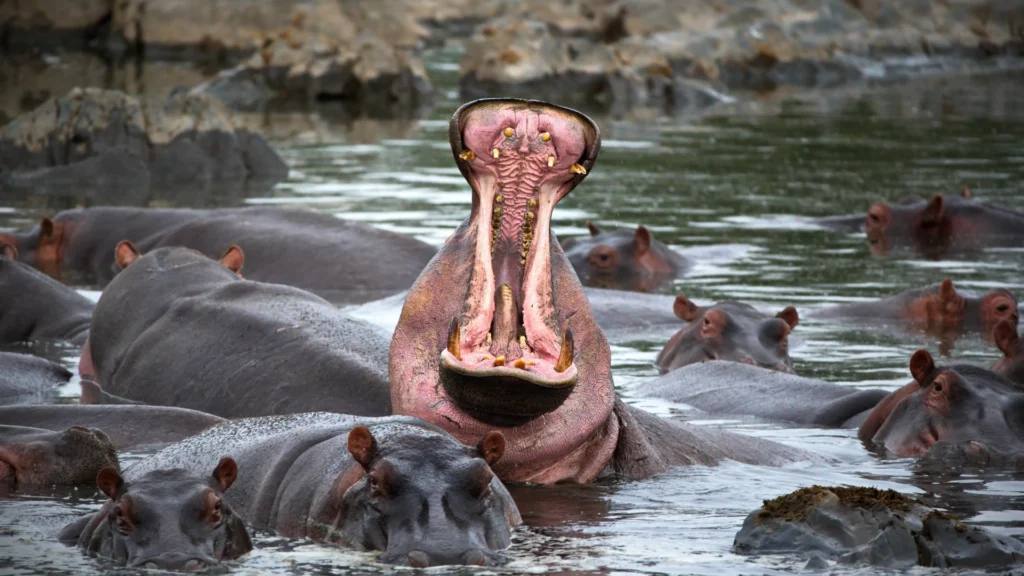
They might be vegetarian, but hippos are very aggressive and territorial. Like rhinos, hippos use piles of dung to mark their territory, and males will flick dung all around with their tail to show dominance. Hippos have a reputation for being the most dangerous animal in Africa – and are statistically more deadly than lions and sharks.6https://www.nationalgeographic.com/animals/mammals/facts/hippopotamus
Sunblock on demand

There is a myth that hippos sweat blood but although they do secrete a red substance, it’s actually a substance produced by glands under the skin which has several protective properties. Scientists named the red pigment “hipposudoric acid” and the orange pigment “norhipposudoric acid”. Like sweat, it helps control body temperature but also has antibiotic properties. Not only that, but scientists discovered it can act as a sunscreen, protecting the hippos’ delicate skin from sunburn.8https://www.nature.com/articles/429363a
Threats to hippopotamuses
Hippos are in hot water. Their numbers are dramatically decreasing due to poaching for their teeth and flesh, and because of habitat loss. In the last 20 years, the hippo population has dropped by a staggering 95 per cent in some areas. According to the Uganda Wildlife Authority, there are now only 300 left in Murchison Falls National Park, and the International Union for Conservation of Nature has classed hippos as a species vulnerable to extinction. However, because they are not considered endangered by the Convention on International Trade in Endangered Species (CITES) despite pressure from conservation groups to upgrade the hippo’s status, some trade in hippo body parts is, sickeningly, still legal.9https://www.bornfreeusa.org/2022/11/23/cites-cop19-update-hippos-not-granted-cites-appendix-i-protections/ It is only a matter of time before hunting, poaching and habitat loss drive the hippo to extinction.
Poaching
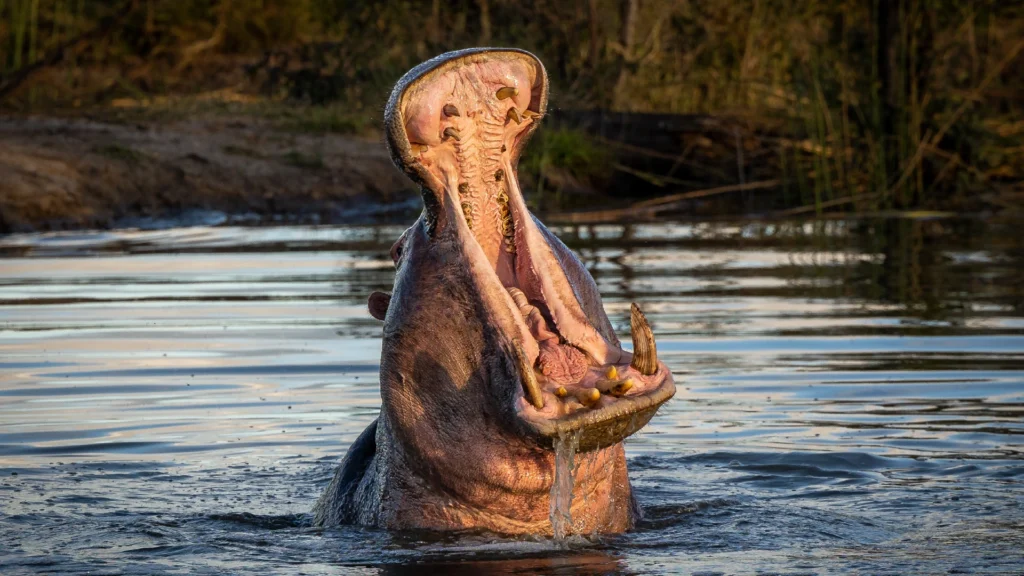
When you think about the illegal ivory trade you might just think of elephants and rhinos, but sadly hippos are also poached for the ‘ivory’ in their canine teeth. As it has become harder and harder for ivory traffickers to target elephants and rhinos because of their dwindling numbers and increased protection, hippos have found themselves in the sinister sights of poachers.10https://www.bbc.com/news/science-environment-63931103 Hippo teeth have become a substitute for the tusks of elephants and horns of rhinos, popular on the Asian market for use in traditional Chinese medicine and for carving ornaments.11https://www.nationalgeographic.com/animals/article/wildlife-watch-hippo-teeth-trafficking-uganda
Hippos are not only poached for their teeth but are also hunted for their flesh – to be eaten as bushmeat – and their skins are used for leather. In the 20 years since 2002, more than 84,000 hippo teeth and 2,500 hippo skins were exported from Uganda according to CITES12https://infonile.org/en/2023/09/underground-ivory-trade-threatens-dwindling-hippo-population-in-uganda-and-drc/, and in just 10 years, Hong Kong reported importing 60 tonnes of hippo teeth – nearly half from Uganda alone.11https://www.nationalgeographic.com/animals/article/wildlife-watch-hippo-teeth-trafficking-uganda
It is estimated that, during the Covid-19 pandemic, when many Ugandans had to resort to desperate measures to make money, an unbelievable 60 per cent of the hippos in Murchison Falls were poached.13https://www.nationalgeographic.com/animals/article/hippos-poached-in-ugandas-national-parks Hunters would set snares along the river banks and wait for the hippos to emerge from the water to graze at night. When the hippo stood in a snare, the wire would entangle and slice into the animal’s leg. The poachers would then approach the terrified hippo and impale them with a spear.11https://www.nationalgeographic.com/animals/article/wildlife-watch-hippo-teeth-trafficking-uganda
The poaching of hippos is not going unnoticed by Uganda’s park rangers, whose reports and aerial surveys have documented declining numbers and missing bodies. When hippos die naturally their bodies remain, but when numbers are dropping and the bodies are missing it’s a telltale sign of poaching.13https://www.nationalgeographic.com/animals/article/hippos-poached-in-ugandas-national-parks
Human-wildlife conflict

As the human population of Uganda grows and encroaches into the natural habitat of hippos, conflict ensues between the two species. Most of this conflict is between farmers and hippos.
More than 200 years ago, farmers were on a mission to exterminate hippos due to crop trampling and raiding. So intense was this eradication that hippos were extinct in northern Africa by the 1800s.14https://www.britannica.com/animal/hippopotamus-mammal-species/ Nowadays, it is mostly fishermen causing conflict as they trespass into the territory of hippos.15https://www.nationalgeographic.co.uk/animals/2021/01/human-hippo-conflicts-are-exploding-in-this-pristine-patch-of-kenya When left alone, hippos mind their own business, but when fishermen wade or boat into their territory, the nervous animals become aggressive and defensive. Hippos kill hundreds of people every year, and most of these are fishermen. As a result of all these injuries and deaths, the fishermen often seek revenge. If a fisherman can kill a ‘problem hippo’, not only does he feel avenged, but he can sell the meat and teeth for an extra profit. Two men jailed for possessing the 234 pieces of hippo ivory in 2016 said the contraband did indeed come from a fisherman.11https://www.nationalgeographic.com/animals/article/wildlife-watch-hippo-teeth-trafficking-uganda
The irony is that research shows that the presence of hippos in rivers actually increases the fisheries’ yield, making the waterways more fertile and productive.12https://infonile.org/en/2023/09/underground-ivory-trade-threatens-dwindling-hippo-population-in-uganda-and-drc/ This is because their dung contains large amounts of nutrients that support fish and aquatic insects.
But it is not only fishermen who come into conflict with hippos. Often women and children collecting water are attacked by hippos. There are many factors which contribute to human-hippo conflict, including flooding caused by climate instability and decline of the hippo’s natural grazing habitat forcing them closer to human settlements. Animal agriculture uses a lot more land than crops so if everyone adopted a vegan diet, the hippos – and Uganda’s other wildlife – would be left with more land to graze themselves, and would not be forced to approach human settlements in search of food.
But this goes to show what happens when humans stray too far into the natural habitat of wild animals. Many fishermen do not have the knowledge to stay safe around hippos, and put themselves in unnecessarily dangerous situations. And then when things go terribly wrong, many call for a hippo cull. What is needed is not a cull, but improved wildlife education, more sustainable ways of making money, and safer fishing methods. As one fisherman said, it is unfair to kill the hippos, the only solution is to learn to live with them.15https://www.nationalgeographic.co.uk/animals/2021/01/human-hippo-conflicts-are-exploding-in-this-pristine-patch-of-kenya

References
References
- 1
- 2
- 3
- 4
- 5
- 6
- 7
- 8
- 9
- 10
- 11
- 12
- 13
- 14
- 15

